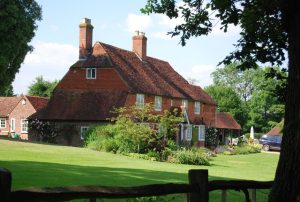Chippens Bank House was reputedly built in 1580. It is a Grade II listed building and the listing describes it as ‘Circa 16th century, timber-framed house, possibly a hall with a modern refacing’. From what I can ascertain it was not a hall house and has certainly been added to over the years.
In the history of Hever Church, written by the Parish Clerk in 1905 it states, ‘In 1633 John Petter was made Rector (of Hever) but was ejected in 1682 under the Bartholomew Act, which enacted that all those clergy who would not subscribe to the declaration of assent to all contained in the Prayer Book and who had not received Episcopal Ordination by St Bartholomew’s Day were to be ejected from their livings.’
In an earlier part of this history it states that John Petter lived on at a house now called ‘Chippens’, (previously known as Petter’s Farm) and died in 1676. When he died he left £10 in his will for the benefit of decayed farmers. This was afterwards converted into a rent charge of ten shillings on his property and is still paid by the owner of ‘Chippens’. No one has recently asked for this payment to be made.
Again, this history of Hever Church states, ‘On the south side of the Church is the tomb of John Chippen who died in 1727 and whose name still clings to a house formerly owned by Mr John Petter.’
The next reference which I can find to Chippens Bank House, as it is now called, was ownership by Captain Richard Streatfield RN, who was born in 1789 and died in 1865. He served under Admiral Lord Nelson at the time of Trafalgar, when he was a midshipman, and he retired from the navy in about 1826. It was at that time that his elder brother, Henry Streatfield of Chiddingstone Castle gave him Chippens Bank House. It is interesting to note that Mr William Streatfield made a substantial contribution to the bells which are hung in the Parish Church of Hever. Captain Richard Streatfield RN on his death left the property to his daughter, Ellen Charlotte Streatfield, who later married the Reverend George Morley MA, and whose family continued to live in Chippens Bank until it was eventually sold to Miss Everest.
Miss Ethel Everest was perhaps best known for the fact that her father, Sir George Everest, was the surveyor of the mountain which o subsequently took his name. Ethel Everest died in 1916 and as far as I can ascertain the next person to live at Chippens Bank House was Miss Emma Cons who was the first female member of London County Council. She lived and died at Chippens Bank House.
Later, the Everest Trust, which was set up so that ‘worthy people could take their holiday somewhere’ was run by Mr & Mrs Howard and Emily Hatcher. At that time the house had four double rooms and two single rooms and was especially noted for its cuisine. It also had full central heating. Breakfast was served from 8.30 am to 9.15am with lunch at 1 o’clock, afternoon tea at 4pm and dinner at 7pm.
The visitors book, which was kindly shown to me by Emily Hatcher, has the first entry on 24th December 1949 and the last on 27th October 1978. People who visited the house and stayed whilst the Hatchers were looking after it included Gilbert Harding, Michael Redgrave, and Lord and Lady Shinwell. Certainly all the entries in the visitors’ book spoke very highly of the restful and peaceful surroundings and everything a holiday should be.
Chippens Bank House was owned by the Everest Trust (which continues to own Chippens Bank Cottages) up until approximately 1980 when it was acquired from the Trust by a Mr Aviss. Mr Aviss carried out a considerable amount of work to the house, both internally and externally. He was also responsible for building a covered swimming-pool and plant room, and subsequently sold the properly. In about 1983 it was purchased by a Mr H G Smith, who was the fly fishing champion of the United Kingdom. In 1985 he applied retrospectively for planning permission to construct a lake and ponds for the breeding and rearing of trout. I am told that, having completed, the lake and stocked it with trout, Mr Smith preferred to watch them rather than catch them.
In November 1987 the house was purchased by Mr Give and Mrs Susan Mattock who lived there until April 1991, when we took it over. We have built a new garage block, refaced the swimming-pool unit so that it is more in keeping with the house, and generally tried to restore the original character to the house. I would certainly concur with the remarks in the Hatcher’s ‘visitors book’ that Chippens Bank is ‘a splendid haven’.
Chris Dane